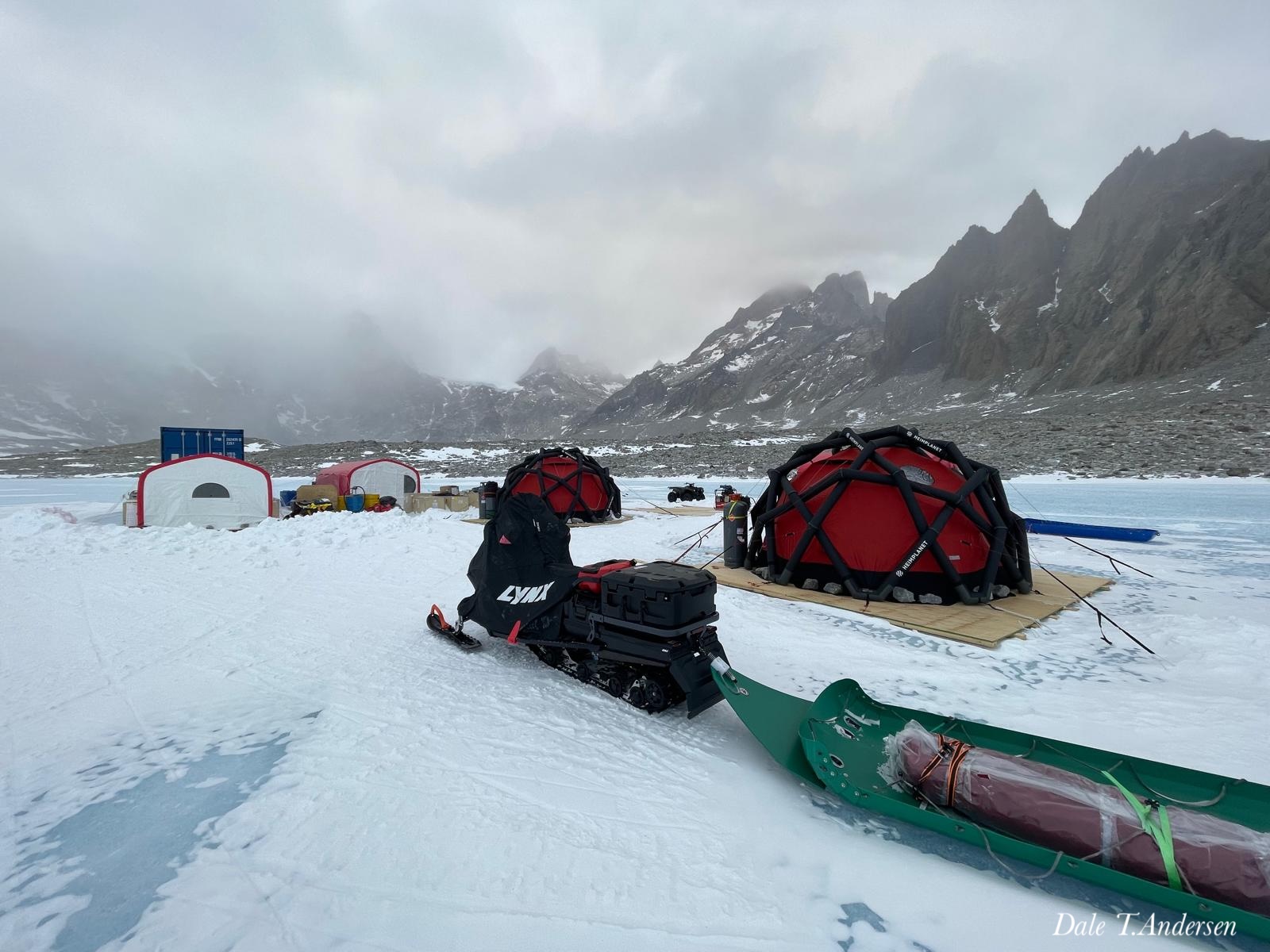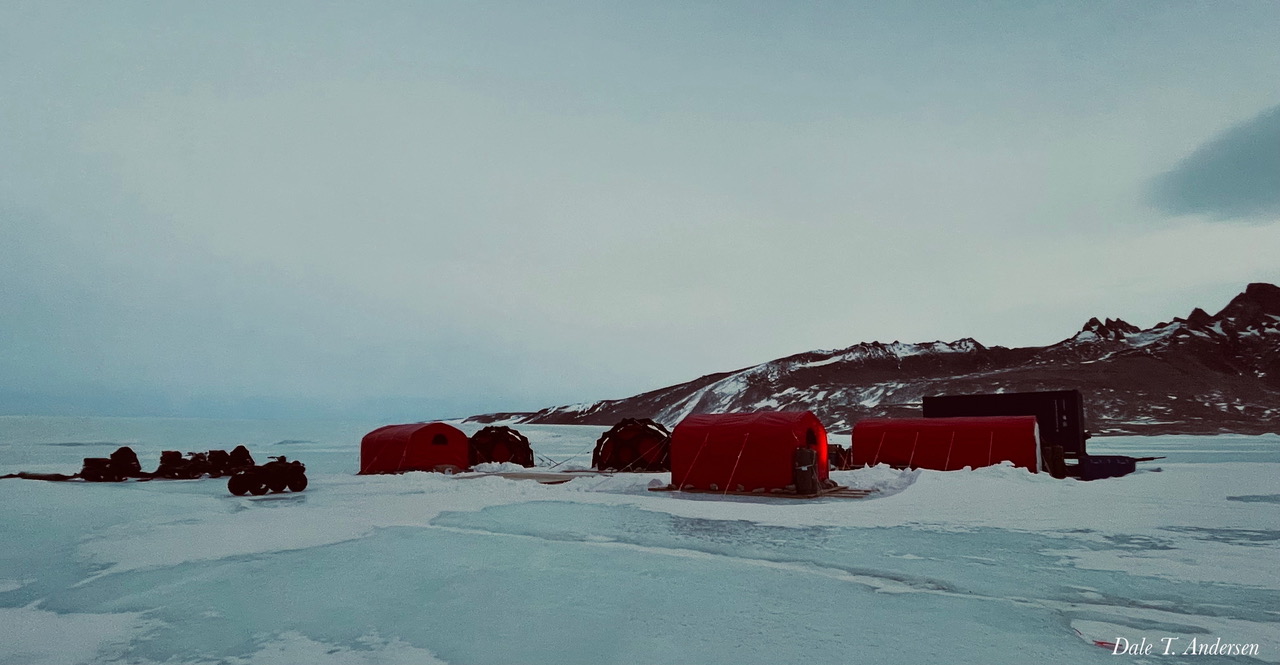
Andersen is senior research scientist at the SETI Institute whose work explores life in extreme environments.
For more about Andersen’s field research, including field research reports from previous years, visit Astrobiology.com
Update #6
SETI institute 40th anniversary Zoom call
Update #5
Hi All - cool day today!

The Plumes of Enceladus
One day, humanity may send a spacecraft to the realm of Saturn, targeting one of its most fascinating moons: Enceladus. This "ocean world," hidden beneath a thick shell of ice, harbors a vast, liquid ocean enveloping the moon—one of the most promising places in our solar system to search for life.
Here on Earth, we prepare for such bold missions by honing our skills in remote and extreme environments. Today at Lake Untersee, while starting a dive hole, we struck a pocket of air (N₂, O₂, Ar) trapped just beneath the ice. The resulting plume erupted in a dramatic, beautiful burst—a small but vivid reminder of the geysers spewing from Enceladus, billions of miles away. Just as the plumes of Enceladus await new discoveries, we’re making exciting finds here at Untersee. We hope to complete the dive hole in the next couple of days—weather permitting!
No one hurt. The drill extension on the left is an extra in case we needed it. The drill did blow completely out of the hole - Alfonso and I had that happen in 2013 at Lake Obersee just up the glacier, but this was a much higher, spectacular one. Pretty fun to see and always nice to have surprises!
When Chris McKay and I drilled the first hole we made in Untersee back in 2008 we had a very similar, but smaller, geyser. A few more here and there over the years but not like this one, which was a lot of fun.
More on this and how it comes about later. Time to get the hole melting coil into the water to make the dive hole at that site!
More on this interesting, seldom seen phenomenon in perennially ice-covered lakes soon!
From the shores of Lake Untersee, Antarctica,
-Dale
Update #4
Hello all
Today, we set up our final shelter from Alaska Structures—a compact 8x10 ft Weatherport. This addition to our camp will serve as a gear storage area and a dedicated workspace for maintaining equipment like portable generators. This new setup enhances our research capabilities, giving us a much-needed sheltered space for technical work and gear protection.

Throughout the day, weather conditions have been gradually changing, with low clouds, light snow, and intermittent gusty windsm moving in. The forecast doesn’t predict extreme winds, but in these remote areas, we stay vigilant. Thankfully, the strongest gusts thus far (42 mph) held off until we had secured the cover on the shelter. We then anchored it to the ice and moved some essential items inside for added protection.
Late yesterday afternoon, we worked in the south basin to set up Dan’s incubation experiment. Despite being pounded with strong gusty winds as we lowered the line into the lake, everything went well, and the incubation is now underway for the coming month.

As soon as the weather allows, we’ll begin honing in on more of our scientific objectives. First on my list is getting a dive hole melted, and we also have a significant amount of survey work ahead. For these tasks, we’ll be using our Trimble GNSS system, featuring sub-centimeter RTK precision with the R12i and R9s base station, an SX10 scanning total station, and a Mavic 3E mapping drone. Looking forward to the next steps!
Cheers from Untersee Oasis!
-Dale
Update #3
from Dale Andersen and his team set up camp at Lake Untersee in Antarctica.
Yesterday’s calm weather allowed us to set up the last WeatherPort for the dive hut and pitch another Heimplanet tent, gradually expanding our camp. With gear getting unpacked and organized, we’re just starting to strike a balance between daily logistics and diving into our science-driven field work.
Today, for example, we’ll make another water run. We have a hole drilled through the 3.6-meter-thick ice about 50 meters from camp. The top of the hole needs a little chipping out to get to the water, but the hole will stay usable for another week or so before it begins to freeze in and we have to re-drill it. Once open, we fill three 5-gallon Igloo coolers that hold our water supply — the coolers slow/prevent the water from freezing in our cook tent, providing us with a few days’ supply for cooking and drinking.
This morning (Friday, Nov 1) around 5 a.m., we faced gusty winds, blowing snow, and low clouds, but things have settled enough for us to head to the south basin and drill our first sampling hole. Dan Fillion, a PhD candidate from ISMER-UQAR, Quebec, Canada, is set to start his second field season of sampling here. In the south basin, intense winds increase ice ablation, so the ice is thinner in this area of the lake—around 2.5 meters compared to 3.6-4 meters elsewhere. Drilling through the ice on this side of the lake takes much less time which is a bonus given the hard, gusty winds that are ever present.
Our camp is steadily taking shape, and as logistics fall into place, we’re easing into the science—finding a rhythm that keeps us warm, safe, and progressing each day.
-Dale

Update #2
from Dale Andersen and his team as they embark on a research expedition to Lake Untersee in Antarctica.

October 20, 2024 -- The stormy weather has cleared and today we are beginning our journey to Antarctica! The team and will board our flight in an hour and after a 5-6 hr flight we will land at the Novolazarevskaya Station ice-runway. Departing for Antarctica now. More soon!
- Dale

Returning to Lake Untersee
Update #1
from Dale Andersen and his team as they prepare to embark on a research expedition to Lake Untersee in Antarctica.
Join us as we return to Lake Untersee in Antarctica to explore the hidden world beneath its thick ice, where a microbial ecosystem dominated by cyanobacteria provides a window to the past revealing Earth's earliest biosphere. This short video is a glimpse into this harsh yet beautiful environment and perhaps a prelude to discoveries that await.
Be sure to Watch in 4K with Sound Up!:
About Lake Untersee:
It's a place few people have seen or even imagined, and distant from familiar, everyday surroundings. The weather can be as harsh as the terrain at times with winds and blinding snow reaching 110 mph. For four months the darkness is company only to the sounds of cracking ice and the ever-present howling of the winds. The surrounding mountains rise up majestically to soaring, pinnacled peaks, blocking the passage of the continental ice that surrounds them. The gentle slope of the Anuchin Glacier flows in from the north halting at its edge. Lake Untersee: within the mountains of Queen Maud Land is a world that resembles Earth's earliest biosphere. One dominated by microbial life forming the same fabrics and structures that we see preserved in sediments dating back 3.45 billion years.
Beneath the thick perennial ice-cover are cyanobacterial mats growing undisturbed as they did billions of years ago—it's like a postcard from the past; one that can help us understand how those early ecosystems thrived on a planet with an atmosphere nearly devoid of oxygen. Yet these cyanobacteria unlocked new secrets for life—they learned to harness sunlight, splitting water to release its hidden energy and hydrogen, which they combined with carbon dioxide from the air to weave the first organic molecules. In releasing oxygen, they ignited a quiet revolution that, over eons, transformed our planet into a world capable of sustaining complex, multicellular life.
Lake Untersee is a difficult place to live and work. But we are seeking new knowledge. Knowledge that will inform us about Earth's past history and help us understand its future. Our research also helps guide the search for evidence of life on other distant worlds such as Mars or the outer moons of Jupiter or Saturn... or beyond.
-Dale Andersen






